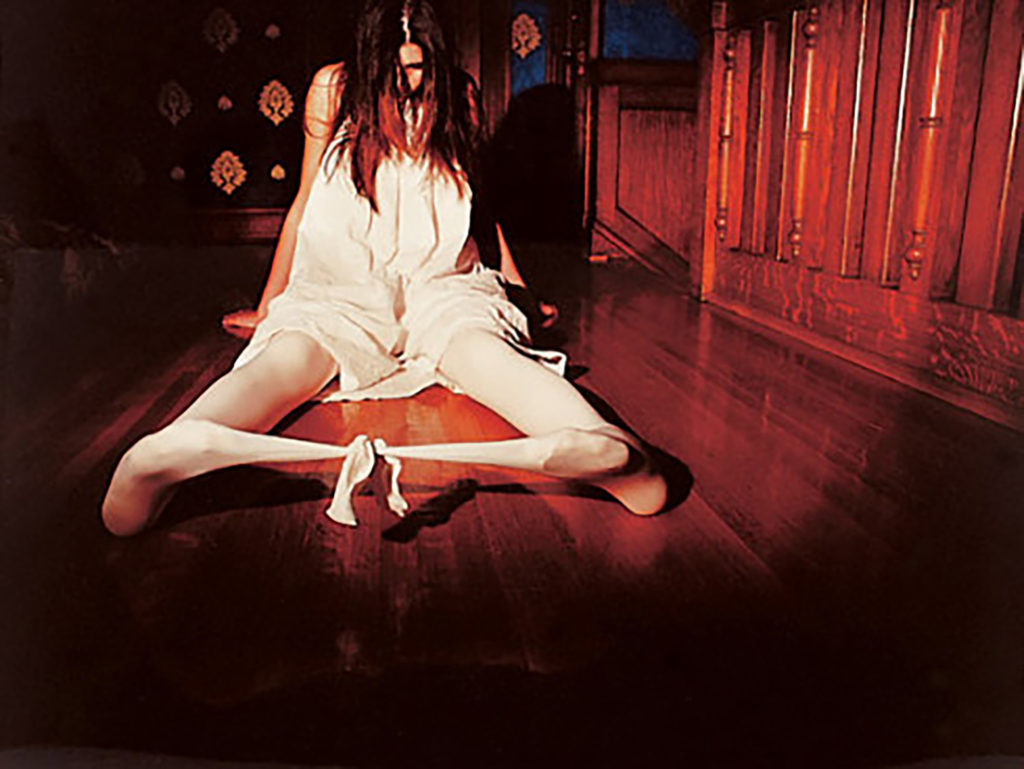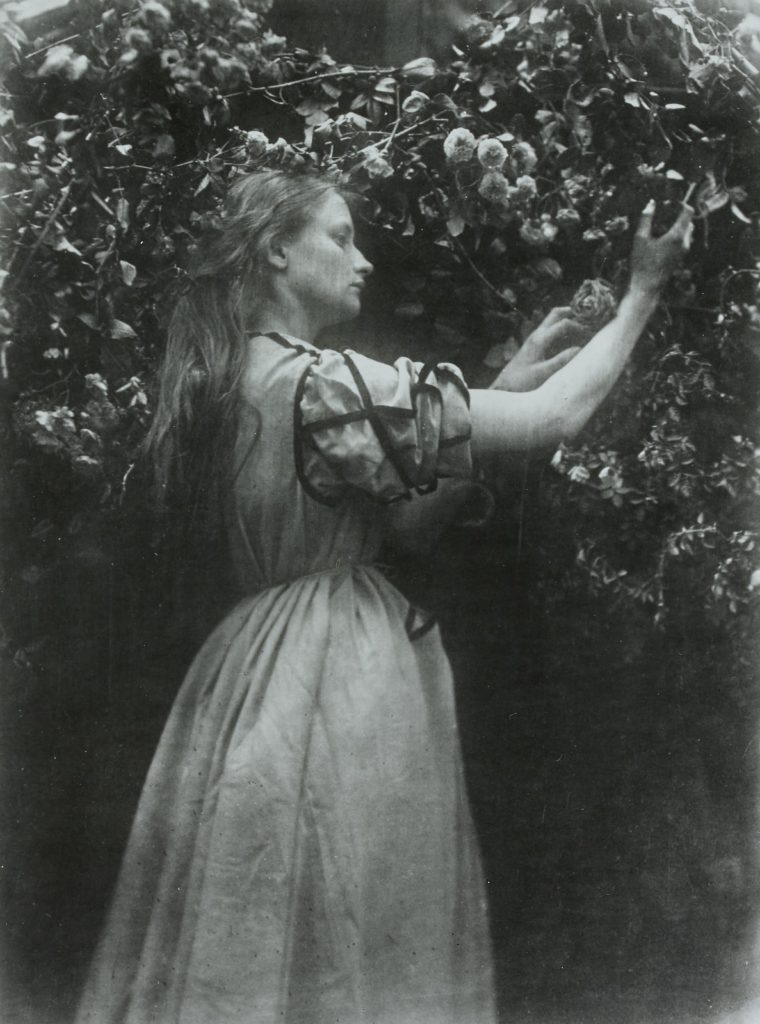How has children’s stories and literature influenced the work of Anna Gaskell and Julia Margaret Cameron?
“…these artists incorporated elements of fantasy, artifice and make-believe into their work.” (Bright . S, 2005 : 78)
Traditionally, throughout the 20th century photography was cantered around capturing the decisive moment, however, we have come to explore the notion of creating this ‘decisive moment’ artificially, constructing scenes made for only the purpose of photography. Tableaux photographs have been made from the beginning of the medium, although Staged Photography emerged as its own known genre in the 1980’s; both ideas involve composing a scene much like a painting, borrowing elements from Pictorialism. Anna Gaskell creates ominous photographs of women, taking themes from literature and children’s’ stories, generating a dream-like narrative in her work. I chose to look at Gaskell due to her staged and tableaux approaches and how she uses her influences to warp them into her own narratives and blurring the lines between fact and fiction. I am going to review the extent to which stories and literature has influenced her work using her imagery for Wonder (1996-97) influenced by Lewis Carroll’s Alice in Wonderland, and Hide(1998) influenced by Brother’s Grimm tale The Magic Donkey. In my own work I intent to explore the stories of the myths and folklore based in my home of Jersey, an island in the Channel Islands Archipelago. Using Gaskell as my influence to explore the notions of the boundaries of a narrative from a literary influence in the visual work and representations of female characters in children’s literature. I plan to explore the narratives with the legendary folktales using tableaux approach set in the real landscape of the island.

‘Hide’, Anna Gaskell 
‘Untitled Film’, Cindy Sherman
Historical Context
The shift from photography being used to produce purely scientific and representational images happened from the 1850s onwards when advocates such as English painter William John Newton suggested that photography could also be artistic. Although initially originating in Britain, Pictorialism spread to be a worldwide movement in photography, seen as the first international art movement in photography. Despite it’s important role in photographic history according to David Bates, Pictorialism is still shown in negative terms due to ‘attracting little or no contemporary critical discussion’ (Bates. D, 2015 : 31), being dominated heavily by imagery of pious sentiment and romantic metaphor. Pictorialism requires time from the viewer due to its use of narrative as well as an understanding of the language of film and culture. In an chapter of ‘Art Photography Now’ this is described to be ‘the mise-en-scene and the dramatic lighting all borrow from the filmic tradition and share seductive qualities of the silver screen’ (Bright. S, 2005 : 78). Pictorialism began to rely heavily on narrative and like Bright discusses, share qualities and traits with the silver screen, some contemporary artists that used this idea is Cindy Sherman who took a post-modern approach in referencing specific cinematic tropes to generate parody and pastiche. Narrative photography, however, relies also on vital sources that veer away from cinema, such as painting, fashion, theatre and literature. Victorian photographer Julia Margaret Cameron referenced popular poems and literature in her photography in elaborate ‘tableaux vivants’, one example of this is Margaret Cameron’s Mountain Nymph Sweet Liberty, where an asserting model stares directly down the middle of the camera, due to this she is also looking directly towards the viewer as she fills the frame of the photograph, this image takes its title from John Milton’s poem L’Allegro, a celebration of life’s pleasures.

‘Mountain Nymph Sweet Liberty’, Julia Margaret Cameron 
‘Untitled #47’, Wonder, Anna Gaskell
Anna Gaskell
Anna Gaskell is a contemporary American artist known for creating contemporary work exploring themes from literature and children’s stories. Gaskell creates ominous images of women that nod to familiar or historic narratives. She explains her process of an attempt “to combine fiction, fact, and my own personal mishmash of life into something new… “(Cascone.S 2017), Gaskell is creating imagery by merging together reality, fiction and her own personal touches of the two warping and blurring the lines between the well-known stories and her own interpretation on them. Creating photographs that depict narratives from literature, Gaskell takes her influences and translates them into her own, stretching the boundaries of the narrative of the stories and literature that has influenced her work. Gaskell’s work dips into the tradition of Pictorialism, using tableaux methods to generate her photographs. Gaskell’s photo series “Wonder” is influenced off Lewis Carroll’s Alice in Wonderland, the work is produced off the back of the idea of isolating dramatic moments from the larger plots. The photographs are staged and planned in the style of ‘narrative photography’, the scenes are artificial, produced and only exist to be photographed.

‘Hide, Anna Gaskell 
‘Hide’, Anna Gaskell
I have chosen to look closer at ‘Untitled #47’ from Anna Gaskell’s series Wonder, the photograph depicts two young girls both dressed identically interacting with each other with a sense of urgency, one towering over the other holding their neck and nose. Although interacting with each other they do not represent individuals, but instead, act out the contradictions and desires of a single psyche, Gaskell’s use of twins for the representation of Alice builds a connection and visual link of identicalness for in which we know they are being represented together rather than individually, while their unity is represented by their identical clothing and looks. Gaskell has staged the photographs to create her own striking visual reinterpretation of Wonderland through the moments of Alice’s physical transformation, the mysterious and often cruel rituals they act out upon each other may be metaphors for disorientation and mental illness. Gaskell’s work has no clear beginning or end containing ambiguous narratives, adding to the emphasis of the unknown and disorientation. This idea is striking in comparison to Alice in Wonderland as the narrative can be originally taken as Alice’s own dreams taken from stories, the character collectively evoked is Alice, perhaps lost in the Wonderland of her own mind, unable to determine whether the bizarre things happening to her are real or the result of her imagination. Gaskell has created a alternative narrative one in which the audience is familiar with, generating a post-modern effect of a simulacra to entice her audience.
In comparison to her series Wonder it is clear Gaskell has been influenced by other stories and pieces of literature which is clear to see in her later series Hide based off Brothers’ Grimm tale The Magic Donkey, this series has been suggested to be her most radical and abstract to date, the title of the series can be linked in reference to the children’s game ‘hide and seek’. In this series Gaskell has again cast young girls as her forefront protagonists, placing them in photographs that emit a sense of nightmarish foreboding and thinly veiled violence. Gaskell’s reference to the Brother’s Grimm story is brought out in the sense of anxiety that she creates with the dramatic lighting and camera angles.

‘Wonder’, Anna Gaskell 
‘Im Garten’, Julia Margaret Cameron
Anna Gaskell and Margaret Cameron both have been inspired by that of Lewis Carroll, equally from his literature and his photography. With almost over 100 years difference between the two photographs they have contrasting ways in which they use staged Pictorialism photography. Gaskell has taken on the darker side of the literary influences, taking a high contrast, menacing point of view in her photographs, whereas Cameron’s photographs are lighter and less intense, the figures in Cameron’s imagery show a sweet and kind aura compared to the sinister persona’s depicted in Gaskell’s imagery. Fairy-tales can often be gruesome, Brother’s Grimm tales were never often sweet and innocent, but rather threatening and perverse, Gaskell has explored this side of fairy-tales in her work rather than a ‘cinematic’ ending. Films and cinema commonly end on a high, Cameron’s work could be seen as taking this pleasant side of literature into account in her photography.
In my own work I explored tableaux techniques as responses to the folklore of Jersey. Using the landscapes of the island where the stories are set I planned my photoshoots to include stage tableaux photographs as well as landscape imagery to represent the legends. While planning my shoots I researched the individual stories, using the documentation, The Channel Island: Les Petits Faîtchieaux, I was able to develop the fairytales of Jersey. The fairies are strongly associated with prehistoric sights; MacCulloch, art historian and academic, notes it was best believed that the fairies inhibited the island before the people who are here now and ‘that the cromlechs were erected by them for dwelling places’ (MacCulloch : 2). It is said people who interfered with the ancient sights would be punished by the fairies. One tale tells of Mr Hocart who broke up the ancient One tale tells of Mr Hocart who broke up the ancient stones of La Roque Qui Sonne for building material who soon after became cursed. Tales are also told of men being blinded by the fairies for disrupting the lands and sights. From tales like this I began to take a cinematic approach to my photographs, having my models staging the tales in chronological order of a story, adding a narrative to the photographs. I edited my photographs so that the colours were enhanced and higher contrast. I did this to add to the other-worldly type effect to enhance the idea of these being folklore and alienated from reality.

‘Beatrice’, Julia Margaret Cameron 
‘Wonder’, Anna Gaskell
My own work has similar attributes to Anna Gaskell’s work and slightly contrast with that of Margaret Cameron’s. I have also chosen to take on a slightly darker side of the fairy-tale with looking at the side of the story that includes curses and the act of blinding. This links to Gaskell’s work which also takes on a darker approach to stories, as well as using the cinematic style of mid-action (photographs compared to Cameron’s images which generally showcase still, gentle figures.) Taking the idea of stillness, I also produced portraits of my models surrounded with a sense of tranquility. I felt this added effect to my narratives to have them posed still and silent juxtaposing my other images. I have connected more to Gaskell’s work with creating a sinister sense of suspense through my photographs with the use of cinematic shots as well as the angles and mise-en-scene I have used.
To conclude, literature has had a large effect on Anna Gaskell as well as Julia Margaret Cameron which has in turn influenced me. Both photographers have taken on two different approaches to interpreting children’s stories and literature, while staying connected by taking on conventions of Pictorialism using tableaux staged photography. Gaskell takes the approach of the darker, more menacing approach, with Cameron representing the lighter, softer side of the stories. Both represent and visually show their influences from literature but in two different ways. In my own work I have also used staged photographs, mixing in the menacing side of the Jersey folklore with the bright high contrast colours adding an alienation to the photographs in order to separate them from the daily life that rests in the landscapes today.



